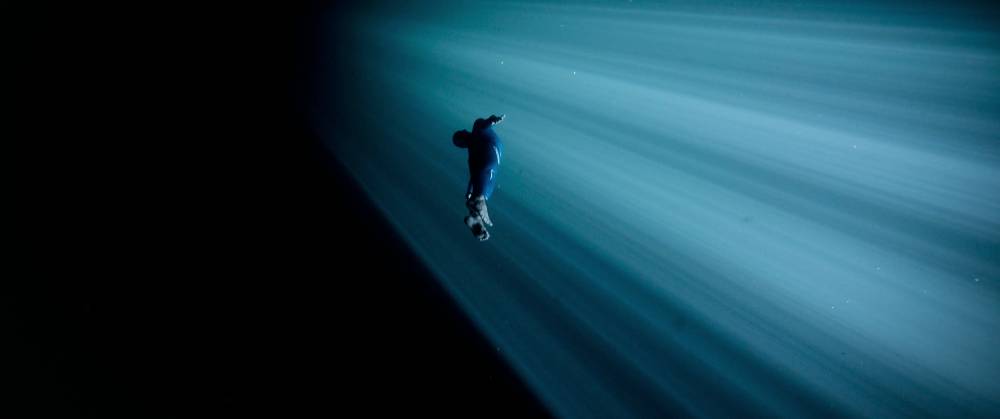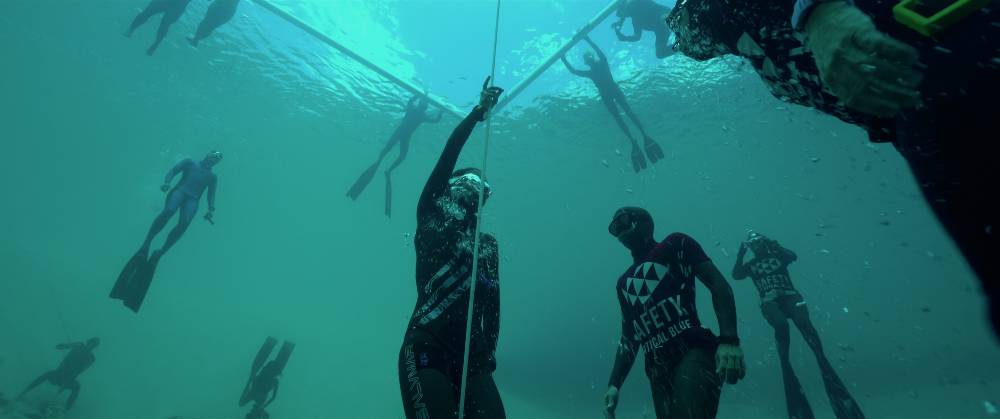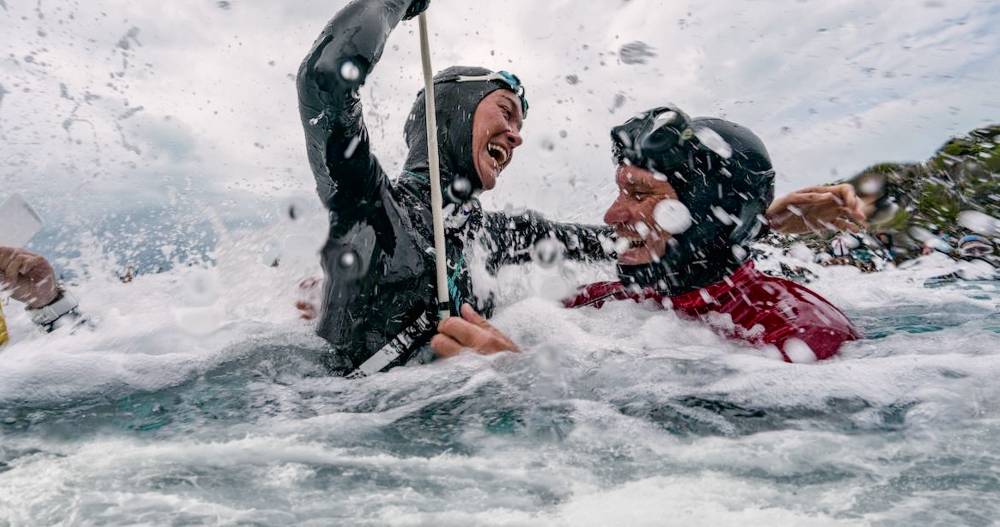Despite striking underwater footage and compelling subjects, Laura McCann’s documentary prioritizes a shock reveal over storytelling, to its detriment.
This piece was written during the 2023 WGA and SAG-AFTRA strikes. Without the labor of the writers and actors currently on strike, the movie being covered here wouldn’t exist.
How long can you hold your breath? A minute? Maybe? Kids time these sorts of things when swimming, but it’s not something most of us think about in our waking lives. But I know that when I swim and misjudge the time it takes to surface, panic sets in almost instinctively. The body wants to live. It takes a particular personality to ignore the body’s demands in apparent life-or-death circumstances. Stephen Keenan and Alessia Zecchini are two such people. Zecchini’s first words in The Deepest Breath, Laura McCann’s documentary about Keenan and Zecchini’s goal to become legendary deep sea free divers, are about how she’s never associated diving with death. I’ll grant a writer is more likely to associate everything with death. But I cannot understand plunging into the darkest depths of the earth while holding your breath for minutes at a time and passing out before you can return without thinking of your own demise. Some of us, I suppose, see a Way where the rest see a void.
The Italian-born Zecchini grew up idolizing Russian diver Natalia Molchanova. The Ireland-born Keenan grew up loving the work of naturalist David Attenborough. While she trained with Italian Olympic swimmers, he traveled to Africa to work with wildlife and respectfully study local customs. While Keenan had planned to return home after a close brush with an attempted coup, he had one stop left on his tour of the continent: Dahab in Egypt. The town’s laid-back atmosphere and beautiful vistas made him feel at home—enough to take a diving instructor job. Dahab is a haven for divers, host to a geographic anomaly called The Arch or The Blue Hole—430 feet of cool darkness, an irresistible diving challenge. Irresistible and lethal—it’s claimed dozens of lives over the years. Zucchini and Keenan met on its banks.

Keenan got into professional free diving, and when he wasn’t competing, he worked as a safety diver—it was his job to, among other things, save divers whose brains shut down to save themselves in the early stages of drowning. A vital role that regularly emphasized the dangers of free diving. Despite this, the couple would not be deterred by the obvious life-threatening risks inherent in the sport—even as Zecchini continued making dangerous mistakes. Keenan became her trainer to help her reach her potential during a contest in the Bahamas. Her form and instincts kept leading her to black out during her dives. With a few hours of his training, she could make the 100-meter depths without passing out. She won several world records under his tutelage. The pair returned to Dahab, Keenan’s adopted home, and started training for more dangerous dives. On one of them, tragedy struck.
The Deepest Breath is situated at a curious crossroads between nature documentaries that explore the limits of human strength and consciousness (think Werner Herzog’s Grizzly Man) and a more traditional National Geographic approach to an extreme sport in a beautiful, remote place. You can sense Herzog’s influence during sections where Zecchini’s father watches her dive hundreds of feet below the ocean’s surface. If the effect is at all similar, the intentions are starkly different. Herzog famously took it upon himself to listen to self-proclaimed naturalist Timothy Treadwell’s final seconds, pointedly not sharing the audio with the audience and warning Treadwell’s loved ones never to listen to the tape. Some things are too profoundly terrible to be folded into something you could call educational, entertaining, or artistic. Director Laura McCann plays by a different set of rules.

The minute I saw the name Bart Layton among the film’s producers, I knew something irksome had to be in store. Layton made a name for himself with the documentary The Impostor, one of the most obnoxiously provocative documentary films of the wave of the early 2010s that saw filmmakers like Robert Greene, Josh Oppenheimer, Bill and Turner Ross and others attempting to deconstruct traditional documentary form; to create a new wave of non-fiction in America. Layton cut a figure more like a prankster out to use the idea of non-fiction as a middle finger to his imagined audience of stuffed shirt PBS subscribers. Layton’s The Impostor and American Animals were content to revel in the criminal sociopathy of their subjects rather than interrogate them or ask broader questions about the culture that produced them. He was content to lionize these figures and give them acres of screen time to talk themselves out of culpability.
While Layton did not direct The Deepest Breath, its most lamentable tick seems like something out of his playbook. For the bulk of the running time, Zecchini and Keenan’s story is kept removed from the testimony of their friends and family, separating them from the telling of their story. When Zecchini finally appears on camera in the present day, it’s meant to mine suspense out of Keenan’s death and get the audience to feel something beyond sadness at his passing. The Deepest Breath wants viewers to wonder which of them made it, if either did, a ghoulish ploy that cheapens its strengths.

And the work is strong if undone by the narrative strategy. The diving footage, captured by people who were there or recreated by McCann where important angles were missing, is engrossing and adeptly deployed. A shot of Zecchini swimming near the surface with her imperfect reflection beautifully captures Keenan’s present absence in her continuing diving. The sense of depth, the enormity, and the danger of the sport are immediately and thoroughly foregrounded. During these showcases, The Deepest Breath asks why people would do this? Is it merely sport if every single attempt at it could kill you? Every sport has risks, but to me, Free Diving is just so obviously the kind of thing you do if you’ve made peace with dying. Curiously, Zecchini hadn’t seemed to until it killed her friend and partner.
That’s The Deepest Breath’s second major flaw—Keenan and Zecchini’s relationship is all but absent from the picture. We know from footage and testimony that they loved each other, and clearly, Keenan cared for Zecchini above all else, but where is her version of that story? By holding Zecchini—the only one who can tell what their life together was like—back for cheap suspense, The Deepest Breath loses Keenan too. McCann never asks those questions. It’s a tragic missed opportunity to get so close and refuse to go deeper.
The Deepest Breath is now available on Netflix.
The Deepest Breath Trailer:
Read next: The Spool's Best New Releases
Streaming guides
The Best Live TV Streaming Services With Free Trial
The praises of live TV streaming services don’t need to be further sung. By now, we all know that compared to clunky, commitment-heavy cable, live TV is cheaper and much easier to manage. But just in case you’re still on the fence about jumping over to the other side, or if you’re just unhappy with ... The Best Live TV Streaming Services With Free Trial
How to Watch Power Book III: Raising Kanan Season 3
Season 3 of the hotly anticipated Power spin-off, Power Book III: Raising Kanan, is arriving on Starz soon, so you know what that means: it’s the ’90s again in The Southside, and we’re back with the Thomas family as they navigate the ins and outs of the criminal underworld they’re helping build. Mekai Curtis is ... How to Watch Power Book III: Raising Kanan Season 3
How to Watch Doctor Who: 60th Anniversary Specials
Ladies and gentlemen, we’re so back! To celebrate Doctor Who’s 60th anniversary, the BBC is producing a three-episode special starring none other than the Tenth/Fourteenth Doctor himself, David Tennant. And to the supreme delight of fans (that would be me, dear reader), the Doctor will be joined by old-time companion Donna Noble (Catherine Tate) and ... How to Watch Doctor Who: 60th Anniversary Specials
Which Netflix Country has Interstellar?
Maybe you’ve just seen Oppenheimer and have the strongest urge to marathon—or more fun yet, rank!—all of Christopher Nolan’s films. Or maybe you’re one of the few who haven’t seen Interstellar yet. If you are, then you should change that immediately; the dystopian epic is one of Nolan’s best, and with that incredible twist in ... Which Netflix Country has Interstellar?
Which Netflix Country Has Each Movie of The Hunger Games?
For whatever reason, The Hunger Games series isn’t available in the same countries around the world. You’ll find the first and second (aka the best) installments in Hong Kong, for instance, but not the third and fourth. It’s a frustrating dilemma, especially if you don’t even have a single entry in your region, which is ... Which Netflix Country Has Each Movie of The Hunger Games?
How to Watch ESPN With A Free Trial
One of the major concerns people have before cutting the cord is potentially losing access to live sports. But the great thing about live TV streaming services is that you never lose that access. Minus the contracts and complications of cable, these streaming services connect you to a host of live channels, including ESPN. So ... How to Watch ESPN With A Free Trial
How to Watch Paramount Network With a Free Trial
To date, Paramount Network has only two original shows on air right now: Yellowstone and Bar Rescue. The network seems to have its hands full with on-demand streaming service Paramount+, which is constantly stacked with a fresh supply of new shows. But Yellowstone and Bar Rescue are so sturdy and expansive that the network doesn’t ... How to Watch Paramount Network With a Free Trial
How to Watch WE TV With a Free Trial
Previously “Women’s Entertainment,” We TV has since rebranded to accurately reflect its name and be a more inclusive lifestyle channel. It’s home to addictive reality gems like Bold and Bougie, Bridezillas, Marriage Boot Camp, and The Untold Stories of Hip Hop. And when it’s not airing original titles, it has on syndicated shows like 9-1-1, ... How to Watch WE TV With a Free Trial
How to Watch TNT Sports With A Free Trial
For many sports fans, TNT is a non-negotiable. It broadcasts NBA, MLB, NHL, college basketball, and All Elite Wrestling matches. And, as a bonus, it also has reruns of shows like Supernatural, Charmed, and NCIS, as well as films like The Avengers, Dune, and Justice League. But while TNT used to be a cable staple, ... How to Watch TNT Sports With A Free Trial
How to Watch Comedy Central With a Free Trial
It’s no coincidence that many of today’s biggest comedians found their footing on Comedy Central: the channel is a bastion of emerging comic talents. It served as a playground for people like Nathan Fielder (Fielder For You), Ilana Glazer and Abbi Jacobson (Broad City), Tim Robinson (Detroiters), and Dave Chappelle (Chappelle’s Show) before they shot ... How to Watch Comedy Central With a Free Trial
How to Watch FX With a Free Trial
You’d be hard-pressed to find a bad show airing on FX. The channel has made a name for itself as a bastion of high-brow TV, along with HBO and AMC. It’s produced shows like Atlanta, Fargo, The Americans, Archer, and more recently, Shogun. But because it’s owned by Disney, it still airs several blockbusters in ... How to Watch FX With a Free Trial